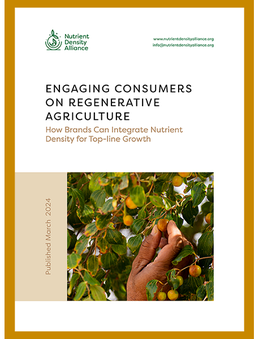Nutrient Density Alliance urges regenerative brands to highlight benefits
Regenerative agriculture can increase crops and brands’ nutrient density, but consumers might not know it. See the benefits of promoting this data.

Farmers pursuing regenerative agriculture hew to a range of practices tied to soil health; the buzzy approach toward cultivating crops revolves largely around improving soil vitality.
Is there a human health angle? Some natural and organic product industry stakeholders say yes. Among other things, crops grown using regenerative methods, they argue, can yield heightened levels of nutrient density—everything from increased protein in wheat to more lycopene in tomatoes.
But industry brands have yet to champion nutrient density, largely due to confusion about marketing nutrient claims and a concomitant lack of nutrient testing.
The reluctance to trumpet nutrient density among brands may soon change, however, thanks to a new white paper by the Nutrient Density Alliance. Engaging Consumers on Regenerative Agriculture is aimed at helping farmers and brands measure and perhaps broadcast the nutrient density of their ingredients and products.
“Right now, most brands get their information from USDA, and use that math for their side panels,” said Tina Owens, managing director of Nutrient Density Alliance. “But anybody can do representative sampling through accredited labs to create more accurate side panels. This isn’t sexy, it’s just changing the specifications on the side panel. It’s the brass tacks of the food system.”
And this minor shift, she said, could lead to a more widespread embrace of brands sporting third-party-tested regenerative agriculture certifications, as well as boosted demand for crops grown using regenerative methods.

Research connects farming methods, nutrient density
Studies conducted by Rodale Institute, the birthplace of the modern organic movement and a nexus of scientific research into organic agriculture, found higher concentrations of nutrients in organically grown oats and winter squash. While Rodale’s research fixes on organic, many regenerative agricultural protocols show similar results. In addition, regenerative agriculture’s most prominent third-party seal, Regenerative Organic Certification (ROC), is built on a foundation of USDA Organic.
A 2022 study by a University of Washington professor concluded that “soil health appears to influence phytochemical levels in crops, indicating that regenerative farming systems can enhance dietary levels of compounds known to reduce risk of various chronic diseases.” Meanwhile, the Center for Regenerative Agriculture at Chico State University in 2022 was awarded a three-year grant to investigate the effects of regenerative agriculture on nutrient density.
For now, the new Nutrient Density Alliance white paper outlines four barriers preventing brands today from talking about nutrient density, along with solutions to each barrier:
Confusion about how higher nutritional outcomes are quantified. Too many people think human health trials must be conducted before businesses can tout nutrient density, the paper says. All brands need to do, however, is engage with existing standard measurement procedures, including ongoing laboratory verification.
Believing there is a lack of scientific evidence. Stakeholders do not understand that evidence now exists and more research resources are being directed toward links between regenerative agriculture and nutrient density. Either way, individual companies can explore the outcomes of their own regenerative agriculture supply in the context of nutrient density.
Believing that additional studies are needed before taking action. The Alliance argues brands and farmers don’t need more studies to begin assessing the nutrient density of their ingredients. What is needed now is widespread industry embrace of nutrient density, including translation of measurable outcomes “to activate consumers and catalyze top-line growth.”
Worries about marketing complicated soil science to engage consumers. Marketing regenerative agriculture already requires referencing complicated science; stakeholders worry that this is just one more hurdle for consumers. But the white paper says simply using the existing model can demonstrate where measurements are proving specific outcomes within a third-party verified regenerative agriculture program. And those measurements can translate to consumer value.
While consumers aren’t yet encountering much messaging surrounding nutrient density, some brands are on the road toward adding it to their marketing quiver. Ancient Nutrition was the first supplement brand to achieve Regenerative Organic Certification. The company, which grows many of its own ingredients using regenerative agriculture methods, is keen to begin touting advances.
“There’s a lot of questions from stakeholders, consumers and retailers about why somebody would pay a premium for this,” said Kristie Cerutti, vice president of impact with Ancient Nutrition. “It may add to the planet’s health, but people don’t want to pay the premium. On shelf, it’s what’s in it for me and my family?’ And we think the key is the concept of nutrient density. If we can get real data and testing, we then can justify for ourselves, our customers and our stakeholders why we are doing this.”
Ancient Nutrition’s first step toward nutrient density transparency hinges on its expansive turmeric crop, grown on the company’s farm in Tennessee (it also owns a farm in Missouri). The company recently found a laboratory to test the nutrient density of its regeneratively farmed turmeric, and anticipates learning the results by April.
Ancient Nutrition is eager to receive the results, which will serve as a baseline for future crops, Cerutti said. As Ancient Nutrition continues improving its soil through regenerative agriculture, will the nutrient density of the turmeric continue to expand?
“If, for example, the results come back and the curcumin (the active ingredient in turmeric) is five times more than conventional, we now on label can say it contains five times more curcuminoids than conventional turmeric. That’s where the labeling component comes in,” she said.
Cerutti characterized nutrient density’s place in the natural and organic products industry as similar to others, like non-GMO and gluten-free, when they were in their infancy. For now, she said, much of the buzz in the industry surrounds regenerative agriculture. But as that becomes more mainstream, “next up will be nutrient density. Because that is the unlock for the consumer.”
About the Author
You May Also Like





